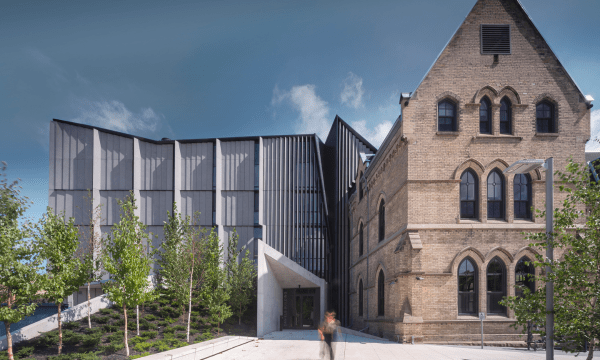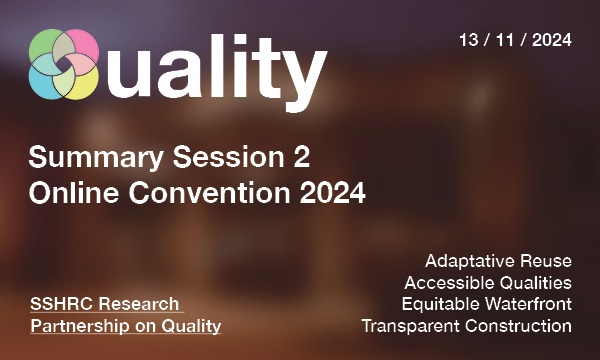Watch the recording of the presentation by Nathalie Dion below
The Toronto 2025 National Quality Convention, held from April 30 to May 2, 2025, was organized by the SSHRC-funded National Quality Partnership as a continuation of the works and momentum built over the past three years. Which aspects of the existing roadmaps could form part of a national quality strategy? This key question was a central discussion topic of the convention. For this purpose, the program included two series of roundtable discussions (April 30 and May 1), along with several plenary sessions dedicated to examining the first series of quality measures together. Another key focus, especially in those plenary sessions, was to facilitate knowledge exchange among diverse stakeholders, showcasing both national and international initiatives aimed at strengthening quality in the built environment. Under this context, Nathalie Dion, member of the steering committee (SC) of this partnership, presented in the third plenary session of Day 2 (May 1) titled: “Adoption of an Architecture policy for Quebec”, offering her insights for the development of Quebec’s National Policy on Architecture and Land Use Planning.
Nathalie Dion is a highly accomplished architect with more than 30 years of professional experience and has been a partner at Provencher Roy since 2021. From 2013 to 2019, she served as the President of the Ordre des architectes du Québec, where she played a leading role in taking initiatives for the adoption of Québec’s first National Policy for Architecture in 2022. A Fellow of the RAIC (Royal Architectural Institute of Canada), she is widely recognized for her commitment to the democratization of architecture and for championing its essential role in public life. In this CRSH-funded National Quality Partnership, she is one of the important and active members of the Steering Committee.
As a former president of the Ordre des architectes du Québec (OAQ) from 2013 to 2019, Nathalie Dion recounted the long process that led to the adoption of Quebec’s National Policy on Architecture and Land Use Planning, which was adopted in 2022. She also presented the implementation plan for this policy. To begin with, she mentioned that they found that, at the initial stage when they started, 20 European countries and regions had architectural policies. She then discoursed about the obstacles they found in Quebec to quality architecture. She also explained different stakeholders related to the policy and spoke about how they combined with different stakeholders to write ‘a white paper’ in 2018, consisting of 7 principles, which are awareness, citizen input, heritage vision, sustainability, public commissions, universal design, and acknowledging architecture’s impact. She later mentioned that the progress of developing a government policy focusing on architecture was delayed till 2022 due to COVID-19.
One of the main focus points of the whole presentation was the explanation of the process of the adoption of this national policy by the government in 2022, where they set 04 broader visions: quality living environments, Land use planning that protects and enhances natural areas and agricultural lands, Dynamic and authentic communities, and Greater attention to land use and architecture. She then presented and elaborated the Architectural Quality Framework, consisting of 11 guiding principles, which are environmental, life cycle cost, cultural heritage, building longevity, responsiveness to needs, context, location, inclusivity and accessibility, experience, health and comfort, and safety. Furthermore, she mentioned that architectural quality generally depends on the 06 conditions for 1) clear definition of needs, 2) adequate timeline, 3) budget aligned with quality target, 4) efficient processes, 5) selection of the team, and 6) post-project review. She remarked that it is noteworthy and inspiring that the government has also recognized the need to reform public procurement (moving away from lowest-bid contracts) to allow creativity, innovation, and higher quality.
For future steps and upcoming works, she talked about the creation of a steering committee, which will work as “Beholder”, to oversee architectural quality. Besides, she mentioned that in the near future, municipalities will be required to integrate quality measures into their development and land-use plans as a mandatory step. In addition, she also mentioned that indicators will be established and monitored every 4 years. As a thought-provoking idea, she further stated, “It takes more than a policy to improve the quality of the built environment.” However, despite progress, concerns remain about maintaining focus on quality amid budget constraints, limited resources for monitoring, and political change.
Watch the recording of the presentation here:



